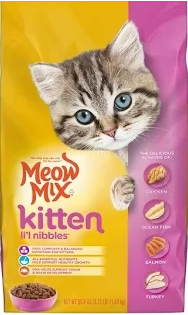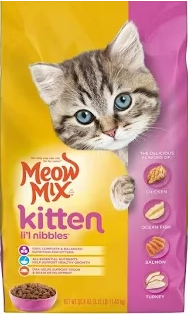
Bringing a new kitten into your home is an exciting and rewarding experience. As a pet owner, one of the most important responsibilities you’ll have is ensuring that your Kitten Dry Food receives the proper nutrition to grow into a healthy adult cat. While there are many types of food available, dry food is a popular choice for many reasons, including convenience, cost-effectiveness, and dental health benefits. However, choosing the right dry food for your kitten can be challenging due to the variety of options on the market. This guide will help you navigate the key factors to consider when selecting the perfect dry food for your kitten’s development.
1. Understanding Kitten Nutritional Needs
Kittens have unique nutritional requirements that differ from adult cats. Since they are in a rapid phase of growth, they need a diet rich in protein, fat, and essential nutrients to support their developing bodies and growing muscles. Choosing a dry food that meets these needs is crucial for their health and well-being.
Key Nutritional Elements for Kittens:
- Protein: Kittens require a higher percentage of protein than adult cats because it helps build and repair tissues, muscles, and organs. Look for dry foods with high-quality protein sources like chicken, turkey, or fish as the primary ingredients.
- Fat: Fat provides a concentrated source of energy, which is vital for kittens’ growth and activity levels. Omega-3 and Omega-6 fatty acids are particularly important for healthy brain development and skin and coat health.
- Vitamins and Minerals: Essential nutrients like calcium, phosphorus, and magnesium are necessary for bone growth and development. Additionally, taurine, an amino acid, is critical for heart and vision health in cats.
- DHA (Docosahexaenoic Acid): DHA is a type of Omega-3 fatty acid that is crucial for the development of a kitten’s brain and eyes. Foods that include DHA are highly beneficial for cognitive development.
- Calories: Kittens have higher caloric needs than adult cats because they are constantly growing and using energy. Dry food specifically formulated for kittens should contain the appropriate number of calories to meet these demands.
2. Age-Appropriate Formulation
One of the most important things to keep in mind when selecting dry food for your kitten is that it should be formulated specifically for their age group. Many brands offer foods that are labeled as being appropriate for “growth and development,” which indicates that the food is designed for kittens.
Kitten-Specific Dry Food vs. All Life Stages Food
- Kitten-Specific Dry Food: This type of food is designed to meet the unique nutritional needs of kittens. It usually contains higher levels of protein, fat, and calories to support their growth.
- All Life Stages Food: Some dry foods are marketed as suitable for both kittens and adult cats. While these foods may meet the minimum nutritional requirements, they may not provide the optimal balance of nutrients for a growing kitten.
For the best results, choose a dry food that is specifically designed for kittens to ensure they are receiving the proper nutrients for their developmental stage.
3. High-Quality Ingredients
Not all dry foods are created equal, and the quality of ingredients can make a big difference in your kitten’s health. When selecting a dry food, always read the ingredient list carefully to ensure that it contains high-quality, wholesome ingredients.
What to Look For:
- Real Meat as the First Ingredient: The first ingredient listed on the label should be a real source of animal protein, such as chicken, turkey, lamb, or fish. Avoid foods that list “meat by-products” or “meat meal” as the primary source of protein, as these can be lower quality.
- Whole Grains or Grain-Free Options: If the food contains grains, opt for whole grains like brown rice or oats rather than fillers like corn or wheat. Click Here For kittens with sensitivities or allergies, a grain-free option may be preferable.
- No Artificial Additives: Avoid foods that contain artificial colors, flavors, or preservatives. Instead, look for natural preservatives like mixed tocopherols or Vitamin E.
4. Size and Texture of Kibble
Kibble size and texture are important considerations, especially for kittens who are transitioning from milk or wet food to dry food. The kibble should be small enough for them to chew easily but also firm enough to provide some dental benefits.
Benefits of Small, Crunchy Kibble:
- Easy to Chew: Small kibble is easier for kittens to manage and digest, especially if they are still developing their adult teeth.
- Dental Health: The crunchiness of dry food can help scrape away plaque and tartar from your kitten’s teeth, promoting better oral hygiene and reducing the risk of dental problems in the future.
5. Brand Reputation and Safety
When it comes to choosing the right dry food, the brand’s reputation and commitment to safety are key factors. Opt for brands that are well-known for producing high-quality pet foods and have a history of safety and transparency.
Factors to Consider:
- AAFCO Approval: Check the packaging for a statement from the Association of American Feed Control Officials (AAFCO) that the food meets the nutritional standards for kittens. This ensures the food contains the necessary nutrients for growth.
- Recall History: Do a quick search to see if the brand has been involved in any recalls or safety issues. A brand with a history of recalls may not be the best choice for your kitten’s health.
- Veterinarian Recommended: Consult with your veterinarian to get recommendations on trusted brands that provide the right balance of nutrition for your kitten.
6. Gradual Transition and Monitoring
Once you’ve chosen the perfect dry food for your kitten, it’s important to transition them slowly, especially if they have been eating wet food or a different brand. A gradual transition helps prevent digestive upset and allows your kitten to get used to the new food.
How to Transition:
- Start by mixing a small amount of the new dry food with your kitten’s current food.
- Gradually increase the proportion of the new food over 7-10 days.
- Monitor your kitten for any signs of digestive upset, such as vomiting, diarrhea, or changes in appetite. If any issues arise, consult your veterinarian.
7. Common Questions About Kitten Dry Food
How Much Dry Food Should I Feed My Kitten?
The amount of food your kitten needs will vary based on their age, weight, and activity level. Follow the feeding guidelines on the food packaging and adjust as needed. Generally, kittens should be fed three to four times a day to accommodate their growing bodies.
Can I Mix Dry and Wet Food?
Yes, many kitten owners choose to feed a combination of dry and wet food. This can provide a balance of the hydration benefits of wet food and the dental benefits of dry food. Just be sure to adjust the total amount of food to avoid overfeeding.
When Should I Switch to Adult Cat Food?
Most kittens can transition to adult cat food around 12 months of age. However, some larger breeds, like Maine Coons, may require kitten food for a longer period. Consult your veterinarian for advice on when to make the switch.
Choosing the perfect dry food for your kitten’s development is a critical part of ensuring their long-term health and happiness. By focusing on high-quality ingredients, age-appropriate formulations, and the specific nutritional needs of growing kittens, you can provide a well-rounded diet that supports their growth, energy, and development. Always remember to consult your veterinarian to tailor your kitten’s diet to their specific needs and monitor their progress to ensure they are thriving on their new food. With the right dry food, your kitten will have a healthy foundation for a lifetime of well-being.


